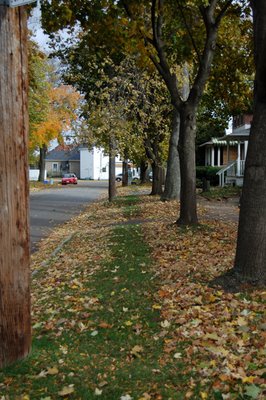Paths
Roadways, sidewalks, and other city passageways connect us throughout the city in a grid-like maze; whether their form is asphalt, concrete, or grass, they leave behind the markings of passage that the person going from point A to point B might leave behind. Philip Evans, in his article Paved Impressions (McBride & Wilcox, pg.96), describes the urban script left behind along the sidewalks of Toronto, where he grew up. Evans claims that cat tracks, city worker’s stamps, spray paint, and cracks all lead to a memory of activity – a palimpsest – of the area that one can interpret to tell something about the surrounding topography. The dilapidated sidewalk, for instance, may tell us something about the property value or how much the city spends on the up-keep of the neighborhood. But how does the architectural language affect the shared experience that the people who walk these paths have? The people that walk along these routes have an intimate and anonymous relationship with these paths and seldom see how they contribute, on a macro level, to the adding and taking away from them.
 Six blocks of yellow line of paint along Scott St.
Six blocks of yellow line of paint along Scott St.



 I used this ready-made path as a point of departure to make something of my own. Similar to the incongruity of the yellow line, I made winding paths of freshly fallen leaves. I guess I hoped that someone would follow, and maybe if I made them slowly enough, perhaps then, we could share in the experience of walking the same path together. On the other hand, were there be no followers, the journey is solitary and the path temporary. I like that, too.
I used this ready-made path as a point of departure to make something of my own. Similar to the incongruity of the yellow line, I made winding paths of freshly fallen leaves. I guess I hoped that someone would follow, and maybe if I made them slowly enough, perhaps then, we could share in the experience of walking the same path together. On the other hand, were there be no followers, the journey is solitary and the path temporary. I like that, too.
Reference: Jason Mcbride and Alana Wilcox Utopia: Towards a New Toronto
 Six blocks of yellow line of paint along Scott St.
Six blocks of yellow line of paint along Scott St.Likewise, the potentially unintentional trace of yellow that lines a sidewalk is evidence of the sifting urban landscape. The line seems to be made of the same paint that is used to divide roadways and direct the flow of traffic. Is its appearance along the sidewalk evidence of creative intervention, or is it simply the product of a clumsy city worker? I followed the line for six blocks before it disappeared, and once again I felt directionless while walking in the city.



 I used this ready-made path as a point of departure to make something of my own. Similar to the incongruity of the yellow line, I made winding paths of freshly fallen leaves. I guess I hoped that someone would follow, and maybe if I made them slowly enough, perhaps then, we could share in the experience of walking the same path together. On the other hand, were there be no followers, the journey is solitary and the path temporary. I like that, too.
I used this ready-made path as a point of departure to make something of my own. Similar to the incongruity of the yellow line, I made winding paths of freshly fallen leaves. I guess I hoped that someone would follow, and maybe if I made them slowly enough, perhaps then, we could share in the experience of walking the same path together. On the other hand, were there be no followers, the journey is solitary and the path temporary. I like that, too.Reference: Jason Mcbride and Alana Wilcox Utopia: Towards a New Toronto

1 Comments:
This is one of the works i used in the catalogue for duncans class... great stuff, i hope all is well.
Post a Comment
<< Home